This is very much a work in progress, but please send any comments to the maintainer Roger Caffin
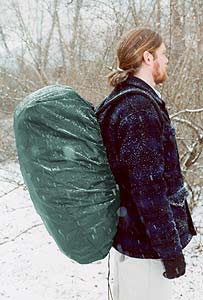
We repeat the picture of this poor guy. Obviously uncomfortable, and obviously he has got his pack all wrong, but how should it be aranged? For that matter, what makes a good design, and why? This page is devoted to exploring the physics of load carrying in practice, and what makes a good pack design. We will draw on research from several places, all of which is happily acknowledged with thanks.
| Contents |
|---|
You may have gathered that I do not think much of the modern internal frame pack design. In fact, I think it is completely misguided. How then should a pack be designed? To answer this requires more than just frills and features; it requires that we consider human ergonomics and how the body functions. It also requires a clear differentiation between the needs of walking with a load and, say, rock climbing with a load. Along the way we will use the term Centre of Gravity or CoG. It means that point in the pack through which the whole pack weight could be considered as acting. It is especially significant in considering how far your pack load is from your back: the farther it is, the higher the leverage or strain on your shoulders. We will also mention the concept of 'Torso length', a term defined by BackpackingLight thus: 'A pack's torso length is measured as the vertical distance between the centerline of the hip belt where the hip belt crosses the iliac crest, and the apex of the shoulder straps. This distance is measured with the back of the pack in its relaxed plane (unweighted) while worn by a user.' They feature a number of studies of pack performance on their web site. First we will look at the physics of the load, then we will look at what carries the load: your body.
For the physicists we have one basic reality: whatever your pack weighs, you have to carry it. Of course, the lighter it is, the smaller fraction of your body weight it represents, and therefore the less you will be influenced by it. There is a group of fanatics in America who strive to get their base pack weight (not counting food, water or worn clothing) down to 5 lb (2.272 kg) from 6 lb (2.726 kg). I have to wonder at this: once the non-food weight is that low, further reductions in non-food don't make a lot of difference. And the comfort factor must be a little low too, not to mention the safety factor.
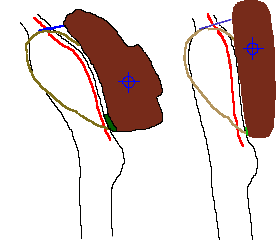
How you carry the weight is however an open question, and that leads to the second reality: how your pack drags back on your shoulders, and how much you have to bend forward to bring it under control. In practice, it isn't the weight of the pack which matters so much as the drag on your shoulders and back. If you doubt this check your back, legs and shoulders at the end of the day. If you are carrying 'conventional' gear, I am willing to bet that it isn't your legs which ache the most!
Two sorts of pack design are shown to the right. The one on the left looks like a conventional internal frame pack with the huge base and the extra pocket on the back. The one on the right is based on an H-frame of the right sort: tall and shallow, with no back pocket. Compare the positions of the CoG on each, and how far forward the wearer of the bottom-heavy pack has to lean forward to get balance. The spines are shown in red. The wearer of the H-frame pack can stand more or less upright, just slightly bent forward at the ankles. The strain is far less this way. Please note: I am basing these figures on my own experiences with several internal frame packs, such as the Macpac Cascade, and my own ultra-lightweight H-frames. The shoulder straps are shown in brown; the Balance Straps (see below) are shown in blue. The waist belt is just shown in spotty brown betwen the pack and the bum.
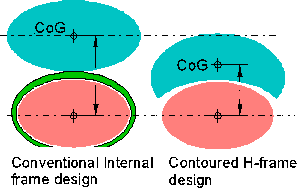
But this simple side view isn't the full story. Let's take a closer look at how the bag fits to your back. The conventional internal frame pack has a terrible feature - called the 'harness'. Each the manufacturer boasts about how their particular harness is the very epitome of design. I am sure they have put a lot of effort into the design, but they have focused on the wrong thing. They have spent a lot of effort making the position of the shoulder strap widely variable (up and down), in a 'one size fits all' approach. This means there is a considerable lump there just to let the position vary: plastic sliders on metal bars and so on. They have also made the back of the pack highly curved, to approximate the curve in your back when you are bent over. Of course, if you straighten up there is then a huge gap there. And they have put a whole lot of padding down the back and especially in the dorsal pad position (at your bum) to try to reduce the pain. The next result of all this is that the nearest part of the pack bag is now positioned a long way off your back. All that design effort was based on having to have a padded hip belt to take the load. This is only very briefly shown in the left hand drawing by the green hip belt, wrapped around a pink waist. The pack bag is blue.
A good design makes sure the load wraps close around your body, to bring the CoG closer to your spine. The bottom of many internal frame packs do this OK, but as soon as you move away from the base the shape reverts to an ellipse, and this pops the CoG further from your back. The alternate approach is to make the frame of the pack approximate the curve across your back all the way up, and to make the bag follow this shape. This is illustrated in the right hand drawing here. See how much closer the CoG is to your spine?
I have said that you also want the CoG as high as possible for bushwalking. Why is this so? Because the higher the CoG is, the less distance you have to lean forward to get it plus your body into balance. When the CoG of your pack is high you only need to lean forward a little bit. Of course, if your are going rock climbing all things change. For rock climbing you don't want a high load on your arms when you're going up something very steep using your arms for assistance. So for rock climbing you want the load down low, near your hips. That's why climbing packs are large at the base. It's a pity so many manufacturers did not understand the difference, and blithely went for the glamour of a psuedo-alpine pack rather than understanding the functional requirements for bushwalking.
You carry your pack on your body, so it makes sense to look at the various parts of your body which interact with the Pack. We will throw in a few extras in here as well. We start by noting that the human skeleton has evolved to walk upright.
Your leg muscles are powerful, your spine muscles are pretty strong, but your arm muscles are weaker. Your leg bones are fairly rigid, so shocks going up them will be transmitted to your pelvic cradle or hip bones fairly well. You can snap the bone at the top of your leg by falling hard with straight legs, or even by falling sidways. However, your head would not appreciate getting the shocks from even normal walking, so your spine is curved and designed to carry the load of the upper part of your body while absorbing shocks and vibrations. You can verify this for yourself: think about those times you have accidentally stepped down with your head back and your spine straight, and jarred your head. But also think of what it is like running: your head does not feel the jarring. Your spine is a built-in load-carrying shock absorber. So, while any load applied directly to your hips will put high stresses on your legs, loads on the top of your shoulders will be cushioned (as long as your spine stays slightly curved).
This means the preferred way to carry a load safely is to have the load transmitted down your slightly curved spine. With a curved spine to buffer the weight of your upper body, you have no trouble: so all you are doing is slightly increasing the weight of your upper body. Fortunately, this is consistent with the idea of carrying a load high: it is fairly easy to transfer the weight to the upper part of your body on top of your spine.
Is this consistent with how most humans carry loads? We need to select examples where modern marketing has not been able to introduce commercial distortions. We should look at methods which have evolved successfully over hundreds of years and learn from them. Two good areas to consider are at native porters in various countries and peasant farmers carrying loads of timber or hay; I am sure you can think of others. What we find in every case is that they do all put the load up high on the shoulders, or even higher. They never try to support the load at the waist. For an extreme case have a look at how African porters carry loads: on their heads. Their flexible spines absorb the load and all the shocks. So why do modern packs manufacturers put they faith in hip belts? We'll get there.
Your spine has nice big shoulders attached to the top end, and these shoulders are really quite strong. Ever watched a weight-lifting competition? Those huge weights are being carried by the bones and muscles of the shoulders - supported in turn by the spine. We are talking hundreds of kilograms here! So your shoulders are well designed to carry a relatively light thing such as a pack. Of course, if we can transfer some of that load directly to your back and spine, without going through the shoulders, so much the better. This is possible.
Let's assume that you have your load fairly high up, and the back of your pack is broad across your shoulders. No, this does not describe most internal frame packs, but bear with me a while. This load is going to press down on the shoulder straps onto your shoulders of course, but you will be leaning forward a little bit for balance, and this means the pack will also be leaning on the broad area across your shoulders. In fact, what happens here is that a properly designed and loaded pack 'wedges' onto your shoulders, with some of the load going directly through your back onto your spine.
Can this actually work? Yes, indeed. Consider carrying two heavy buckets of milk a distance, one in each hand. Your shoulders will soon start screaming. But now hang those two heavy buckets off a traditional milkmaid's yoke, placed across your shoulders. The load is off the tips of your shoulders and onto the far stronger part near your spine. In fact, milkmaids used to carry heavy loads this way while still smiling. Well, they did if there was a camera around. But note one detail: the load is downwards, not backwards! We will return to this shortly.
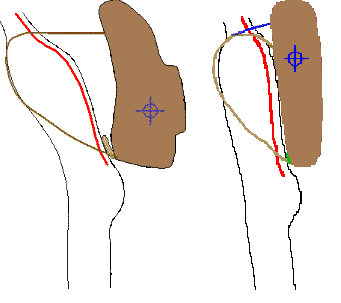
If we are going to place some load on your shoulders, we should consider the direction of that load. If the pack is really leaning backwards, as those old A-frames were wont to do, you have to counter that by pulling forwards with your shoulders and curving your spine (shown in red) lots. Those muscles did not evolve for sustained load carrying forwards and they are going to get very tired doing that. Your spine can carry a large load, but in compression down the bones: quite a different thing. So are your back muscles as they pull forwards: it's an un-natural effort. This means you don't want the load pulling backwards from your shoulders. A poorly adjusted pack can do just that, as shown in the snowy picture at the start and (somewhat exaggerated) by the left hand figure in the picture to the right. Note especially how the straps are really pulling straight backwards, against the shoulders.
A partial solution to this general problem has been the addition of 'Balance Straps' at the top of the pack to pull the top of the pack in towards your shoulders. I have no idea where the name came from: it does not seem very appropriate. Well, they do help if you use them properly. They do allow you to pull the load and the CoG in as close to your back as possible, as illustrated by the right hand figure in the picture here. This actually takes a lot of load off your shoulders. However, they are not a complete solution by themselves.
A word of warning about just how tight you pull the Balance Straps. Yes, they are meant to pull the pack in to your back, but no further. Do not pull so hard on the Balance Straps that the bit of the shoulder strap going from the Balance Strap connection back to the pack is at all slack. This bit of the shoulkder strap must stay under load. If you make it at all slack you will make life very hard (ie painful) for yourself. What happens then is that the load pulls back along the Balance Strap, a similar problem to that shown in the picture here, but worse. The straps will then be pulling backwards on your shoulders, which is completely stupid, and they will get very tired and possibly rubbed raw. So pull on those straps gently, just until you sense that the pack is up against your back, but let the shoulder straps carry the load. A mirror may help here.
"But modern internal frame packs have such sophisticated hip belts!" Yes, but 'sophisticated' doesn't mean they work all that well. For a start, putting all the load on the hips can be rather disfunctional for anyone whose hips move a lot while they are walking, and womens' hips do tend to do that, don't they? There are good anatomical reasons for this involving differences in how the hip-bones and gluteus maximus (aka bum) muscles work between men and women (quite apart from the charm it has in mens' eyes). So the whole hip-belt design has serious problems for females. Maybe there is a reason why manufacturers of internal frame packs keep trying to improve their hip belt designs - they still don't work all that well?
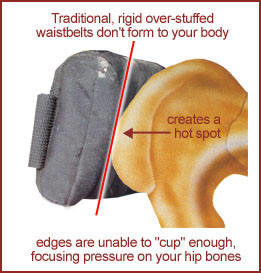
But there are also very good structural and anatomical reasons for not putting all the load on anyone's hips. For a start, doing so has to place a very high compression around your waist or hips. I have seen one American 'expert' claim that you should do up the hip belt until it is almost painful - "you will get used to it", he says. Not so much weird as completely raving stupid. But worse, I find that it tends to constrict my guts, and that produces severe cramps after a while. Not wierd, but fundamentally stupid. If the hip belt is so large and stiff, as many of them are, the bottom edge digs into the top front of my leg muscles when I step up very high. Crawling down river banks over boulders and through jungle sees a lot of high-stepping. Finally, and most seriously, putting the load directly on my hips increases the shock loading on my hip bones, leg bones, ankle bones and feet when I walk. They get tired more quickly, and are under a greater risk of injury. I say the basic concept is wrong: the load should not be carried directly on the hips.
There is a worse hazard for the hips than getting tired. If you place a lot of pressure on your hip bones, and those hip bones are not well padded, you can cause some anatomical damage. The bone may respond to the continued pressure and rubbing by growing protective lumps. Unfortunately this simply makes everything worse! The more the bone sticks out, the worse the pressure. You could perhaps also cause some damage to the skin, although the bones usually cop it first. Basically, your hip bones were never meant for this sort of treatment. Yes, I know, the manufacturers puts lots of padding on their hip belts - now you know why. We will come back to this shortly.
Now it is worth looking at a couple of older ways of attaching the load to the wearer. One method uses rigid hooks off the back of a basket. (One would like to assume the hooks were comfortable, but I am not sure there was much padding!) The idea here is that the rigid hooks will not let the load move backwards, away from your shoulders. The hooks keep the load right over your spine, and help transfer the load to your spine through your shoulders. I've seen old pictures of European peasants carrying huge loads of hay and produce this way. (Today they use tractors.) The important thing to notice is that the load is very high, probably above the wearer's shoulders. Getting overall balance is then quite easy, although walking up a hill might be harder!
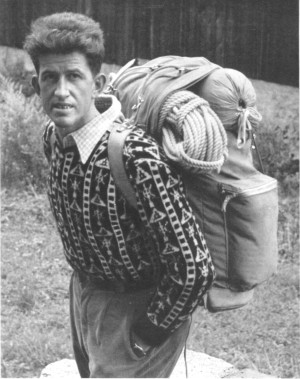
Rebuffat in his absolutely superb book 'On Snow and Rock' wrote in 1963:
However, there is about rucksacks a legend and a habit which die hard. Until quite recently the mountaineering rucksack, like the camping rucksack, was in the shape of a pear which hung down the climber's back, forcing him to lean forward in an unnatural way to compensate for the weight behind him.A sensibly designed rucksack, however, should be high rather than wide and narrower at the base than at the top, thus corresponding with the anatomy of the humab body which is wider at the shoulders than at the waist. Such a rucksack might draw its inspiration from the baskets of the Savoy peasants, in which they carry 160 lb [73 kg] of potatoes without being thrown off balance, and from the 'hooks', tall back frames upon which the weight rests, not low down but high up on the back. These enable the men who provision the mountain huts to carry 120-140 lb [54 - 64 kg] of food up over rough mountain paths, a quite impossibler type of undertaking with the usual type of rucksack.In fact, it is a good deal more arduous to carry 80 lb [36 kg] in a sort of rucksack one sees in use at present than double that weight in a peasant basket or on 'hooks'.
Another old method is the head-band with a basket, frequently used even today by Nepali porters. This mechanics here are a little more complex. The headband keeps the load from swaying backwards, as do the basket hooks, but it also makes the load press hard against the wearer's back. Once again, the load is kept very high so it can press down on the shoulders and back. Friction here helps transfer some of the load off the neck muscles onto the back at the shoulder region. (Yes, I have tried this in Nepal.) I am told that the neck muscles do get a bit tired the first few times, but that you do get used to it, and anyhow the neck does not carry the load: the back does. I believe the standard porter load is 45 kg, although many porters have been known to carry a double load for extra money.
Finally, consider how some Africans and Arabs carry loads: on top of their heads! The classic pictures of African porters show the loads on their heads, and Arabian women carry big pots of water from the well to the house on their heads. OK, they have some padding there, but if ever a load went down the spine, this would be it! And yet, they all seem to walk along quite easily. The load is balanced, and the spine is cushioning the load. Why do they do it this way? Because it works.
If you look in the catalogues you will see that the vendors all argue that most of the load should go on your hips, not on your shoulders. Of course they say this: they sell internal frame packs. I say this is wrong. If you take this idea to the logical extreme you might think you should carry all the weight on your hips with the shoulder straps loose. You can, but you would have to lean your upper body way forward to get it out of the way of the pack so the Centre of Gravity (CoG) of the pack is above your hips (but what about your own CoG?). We have been there with the old A-frame pack, and all the back-ache that caused. If you have never carried an A-frame pack, don't bother trying. One thing is already clear: you want the CoG as close to your back as possible.
I have argued that the current internal frame packs are poorly designed for bushwalking, even if they were well-suited to alpine climbing. Is it possible to do any better? In short, yes. First, let's use all the above to consider what we need to achieve.
In America the Kelty packs are still based on a modified version of the H-frame, and are still widely acknowledged to be good mass-market load-carrying packs. These packs are not pure H-frames as they do rely partly on a hip belt. However, they do allow the walker to travel upright, leaning forward slightly at the ankles. LuxuryLite is another such brand. There are probably other brands as well. You have to actually wear a real H-frame pack with a big load to appreciate just how good they can be.
One of the funniest myths propagated by vendors of internal frame packs is that the gap between the pack and your back is essential for ventilation. Well, any pack wearer will tell you that the ventilation doesn't work! Your back gets sweaty. But that doesn't mean you need ventilation there anyhow. Think how nice it is when you put your pack on your back on a cold windy day: the pack actually shelters your back. When I was carrying 30+ kg in an H-frame with sponge rubber right down my back as padding, I did not feel my back needed ventilation. A warm back is much safer than a cold back, after all. My own opinion of this ventilation claim is that the vendors are trying to convert an embarrasing gap into a marketing benefit.
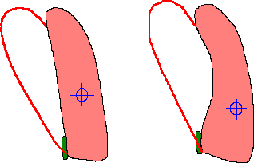
Before abandoning theory, we should look at whether a frame actually contributes to the comfort of a pack. After all, frames add weight: is this justified? Most experienced walkers know the answer: definitely yes. But we can add some reasons and numbers to this.
Consider first a frameless pack. It can be stuffed full so it is rigid, or it can be a bit flexible. If it is flexible it is going to sag away from your back, and this is going to push the CoG further from your back. The result is immediately that the pack will be less comfortable: there will be more strain on your shoulders. Also, because the pack is now separate from your back, it will move sideways as you walk, throwing the load on one shoulder at a time. This adds further strain.
Some walkers try to overcome this by placing their sleeping mat inside the pack down the back, or even rolled up around the inside of the bag with everything else inside it - like a 'rolled cylinder'. Well, this is a fine idea, but it too has disadvantages. If your mat is foam it can take a bit of bashing, but if you have an airmat you should realise that there is now very little between your airmat and all those spikey bushes out there. In the thorn scrub around Sydney, I wouldn't reckon you would get to the first night with an air mat intact! The second disadvantage is that your mat is going to get any rainwater which leaks into your pack all over it. The result will be a wet mat when you unpack. Good for your sleeping bag of course. Then there is the round shape this will put your bag into: a really good shape for pushing the CoG as far from your back as possible.
So much for words. Backpackinglight (BPL) did some wearer tests on this. They used a scoring system thus:
| Score | Description |
|---|---|
| 5 | Exceptionally comfortable |
| 4 | Noticeably comfortable |
| 3 | Neutral comfort (user would not want to carry more weight than this for long periods of time) |
| 2 | Noticeably uncomfortable |
| 1 | Exceptionally uncomfortable |
Starting with scores around 5, they found that the wearer started to notice a difference between framed and frameless packs by 5 kg; by 10 kg the framed pack had dropped to a score of 4.5 but the frameless pack had dropped to 2.5. By 15 kg the framed pack had dropped to a score of 4, but the frameless pack was down almost to 1.
What the authors of the article were arguing, with some success, was that "A pack's ability to optimally bear weight depends on its ability to maintain a weight-bearing torso length that is equal to or greater than the effective user torso length." For this to happen it needs some sort of frame, otherwise the sagging shortens the torso length. Their results did support this argument quite well, showing good correlation between loss of comfort and a sag in torso length. This has led them to argue that 'torso length' is a good measure of load-carrying efficiency (and comfort). Their analysis did not explicitely take into account the way the CoG moves away from the body when the bag sags, but this may be covered by the comfort measure. Frankly, I think they would have done better by trying to measure how much the sag pushed the CoG away from the wearer's back. I think that was the real factor in play here. Anyhow, our interest in their results lies in the weights where things started to go bad, and where they got very bad. Frameless day packs don't normally get much above 5 kg. Lightweight walkers might manage a pack of only 10 kg (including food), but many walkers will have a pack of 15 kg (or more). It would seem that a frame of some sort is a Good Thing to stop the bag sagging and the CoG moving away.
With this measurement scale somewhat validated, BPL went on the consider the 'rolled cylinder' idea, to see whether it works in practice. They tested this by taking one pack which could have its frame removed, and looking at how much the torso length could change under load. Basically, they found that the addition of the 'rolled cylinder' did not prevent the sag: adding the rolled up mat did not make much difference to what shape the pack took. On the other hand, adding a proper frame did significantly improve the shape. Framed packs do control the shape of the bag, at least to some degree.
You sometimes see novices tying their sleeping bag and other gear on the outside of the pack, or even to the bottom of the pack. Apart from the effect this has on the CoG, such an act can be disasterous in wet weather or bad scrub. I found a sleeping bag half-way down a steep hill once: obviously it had been tied on the outside. (It was a cheap one - draw your own conclusions.) I wonder what the camper did that night? Obviously your sleeping bag should go inside your pack. So should any other heavy objects.
One thing which annoys many of us is the practice some people (especially novices) have of carrying a foam mat unprotected on the outside of a pack. This leads to the ground being littered with little bits of coloured ripped-off foam. You know when you are on a popular track used by novices: there's foam marking it like Hansel and Gretel breadcrumbs. This is just plain thoughtlessness by such people. Let's just say that all gear should be inside the pack, or at least covered by a strong bag if it is on the outside of your pack.
© Roger Caffin 4/June/2005